否定结构的翻译
- 格式:doc
- 大小:38.50 KB
- 文档页数:9
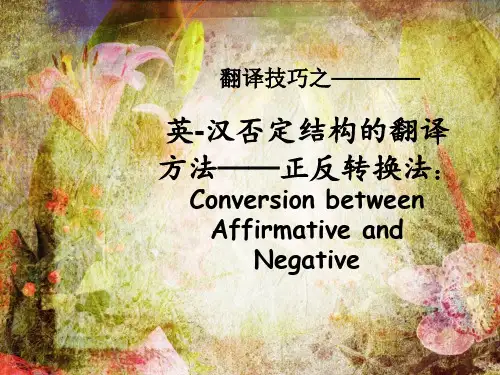
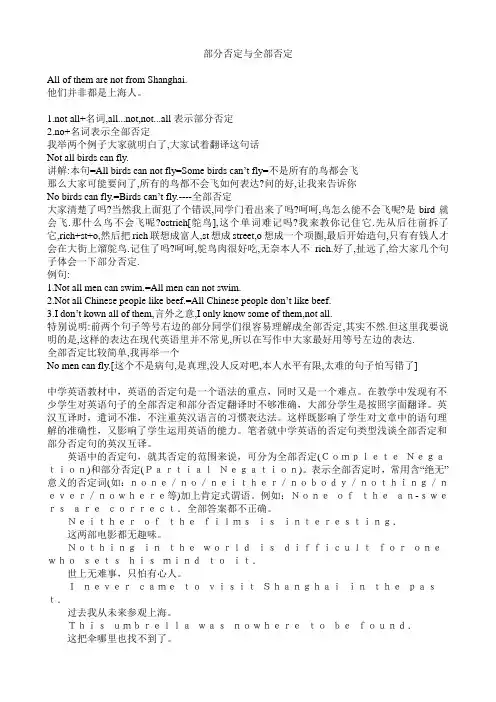
部分否定与全部否定All of them are not from Shanghai.他们并非都是上海人。
1.not all+名词,all...not,not...all表示部分否定2.no+名词表示全部否定我举两个例子大家就明白了,大家试着翻译这句话Not all birds can fly.讲解:本句=All birds can not fly=Some birds can’t fly=不是所有的鸟都会飞那么大家可能要问了,所有的鸟都不会飞如何表达?问的好,让我来告诉你No birds can fly.=Birds can’t fly.----全部否定大家清楚了吗?当然我上面犯了个错误,同学门看出来了吗?呵呵,鸟怎么能不会飞呢?是bird就会飞.那什么鸟不会飞呢?ostrich[鸵鸟],这个单词难记吗?我来教你记住它.先从后往前拆了它,rich+st+o,然后把rich联想成富人,st想成street,o想成一个项圈,最后开始造句,只有有钱人才会在大街上溜鸵鸟.记住了吗?呵呵,鸵鸟肉很好吃,无奈本人不rich.好了,扯远了,给大家几个句子体会一下部分否定.例句:1.Not all men can swim.=All men can not swim.2.Not all Chinese people like beef.=All Chinese people don’t like beef.3.I don’t kown all of them,言外之意,I only know some of them,not all.特别说明:前两个句子等号右边的部分同学们很容易理解成全部否定,其实不然.但这里我要说明的是,这样的表达在现代英语里并不常见,所以在写作中大家最好用等号左边的表达.全部否定比较简单,我再举一个No men can fly.[这个不是病句,是真理,没人反对吧,本人水平有限,太难的句子怕写错了]中学英语教材中,英语的否定句是一个语法的重点,同时又是一个难点。
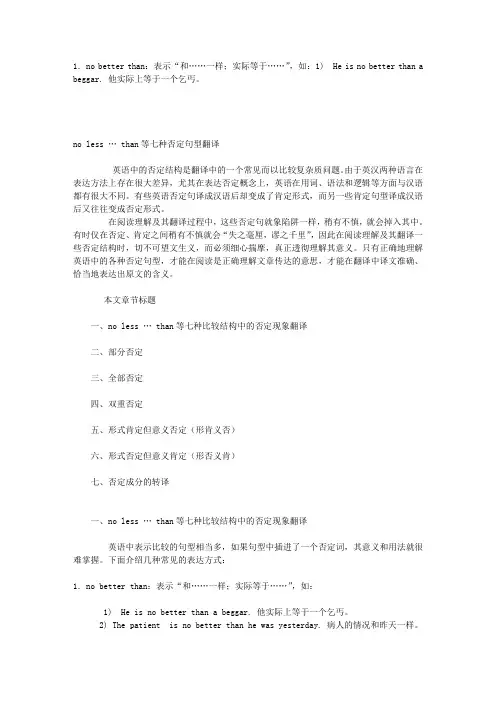
1.no better than:表示“和……一样;实际等于……”,如:1) He is no better than a beggar. 他实际上等于一个乞丐。
no less … than等七种否定句型翻译英语中的否定结构是翻译中的一个常见而以比较复杂质问题。
由于英汉两种语言在表达方法上存在很大差异,尤其在表达否定概念上,英语在用词、语法和逻辑等方面与汉语都有很大不同。
有些英语否定句译成汉语后却变成了肯定形式,而另一些肯定句型译成汉语后又往往变成否定形式。
在阅读理解及其翻译过程中,这些否定句就象陷阱一样,稍有不慎,就会掉入其中。
有时仅在否定、肯定之间稍有不慎就会“失之毫厘,谬之千里”,因此在阅读理解及其翻译一些否定结构时,切不可望文生义,而必须细心揣摩,真正透彻理解其意义。
只有正确地理解英语中的各种否定句型,才能在阅读是正确理解文章传达的意思,才能在翻译中译文准确、恰当地表达出原文的含义。
本文章节标题一、no less … than等七种比较结构中的否定现象翻译二、部分否定三、全部否定四、双重否定五、形式肯定但意义否定(形肯义否)六、形式否定但意义肯定(形否义肯)七、否定成分的转译一、no less … than等七种比较结构中的否定现象翻译英语中表示比较的句型相当多,如果句型中插进了一个否定词,其意义和用法就很难掌握。
下面介绍几种常见的表达方式:1.no better than:表示“和……一样;实际等于……”,如:1) He is no better than a beggar. 他实际上等于一个乞丐。
2) The patient is no better than he was yesterday. 病人的情况和昨天一样。
3) He has no better a say in the matter than I have.他和我一样在这件事上没有发言权。
2.not. . . any more than或no more. . . than:表示“同……一样不”,如:1) I could no more do that than you. I could not do that any more than you. 你不能做这件事,我也不能做。

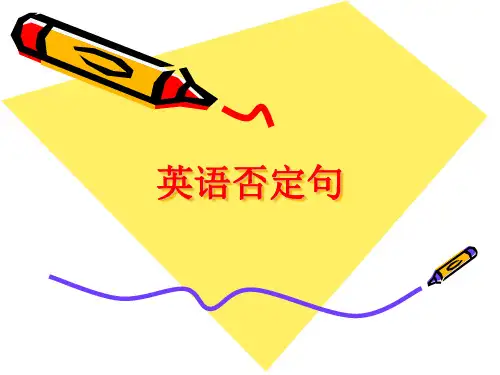
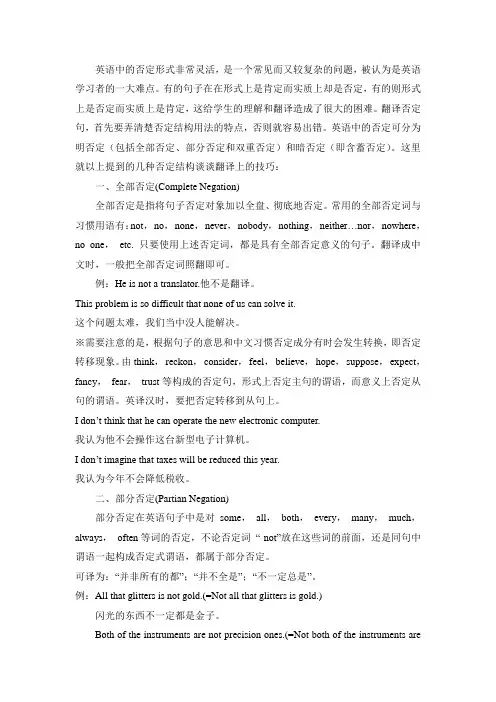
英语中的否定形式非常灵活,是一个常见而又较复杂的问题,被认为是英语学习者的一大难点。
有的句子在在形式上是肯定而实质上却是否定,有的则形式上是否定而实质上是肯定,这给学生的理解和翻译造成了很大的困难。
翻译否定句,首先要弄清楚否定结构用法的特点,否则就容易出错。
英语中的否定可分为明否定(包括全部否定、部分否定和双重否定)和暗否定(即含蓄否定)。
这里就以上提到的几种否定结构谈谈翻译上的技巧:一、全部否定(Complete Negation)全部否定是指将句子否定对象加以全盘、彻底地否定。
常用的全部否定词与习惯用语有:not,no,none,never,nobody,nothing,neither…nor,nowhere,no one,etc. 只要使用上述否定词,都是具有全部否定意义的句子。
翻译成中文时,一般把全部否定词照翻即可。
例:He is not a translator.他不是翻译。
This problem is so difficult that none of us can solve it.这个问题太难,我们当中没人能解决。
※需要注意的是,根据句子的意思和中文习惯否定成分有时会发生转换,即否定转移现象。
由think,reckon,consider,feel,believe,hope,suppose,expect,fancy,fear,trust等构成的否定句,形式上否定主句的谓语,而意义上否定从句的谓语。
英译汉时,要把否定转移到从句上。
I don’t think that he can operate the new electronic computer.我认为他不会操作这台新型电子计算机。
I don’t imagine that taxes will be reduced this year.我认为今年不会降低税收。
二、部分否定(Partian Negation)部分否定在英语句子中是对some,all,both,every,many,much,always,often等词的否定,不论否定词“ not”放在这些词的前面,还是同句中谓语一起构成否定式谓语,都属于部分否定。

第11讲英文否定结构的汉译1. 双重否定结构1) 译为肯定(1) Nothing has been done that can’t be done better.(2) God never closes a door without opening another one.(3) The star can’t go anywhere without being the center of attention.(4) In our work it’s nothing unusual to be confronted with failures.2) 译为双重否定(1) There exists no language or dialect in the world that can’t convey complex ideas.(2) The works of poets serve no other purpose than revealing the truth and meaning of life.(3) Small-minded officials, rude waiters, and ill-mannered taxi drivers are hardly unknown in the US.(4) Modern society cannot do well without the contribution that women can make in the professions and other kinds of work.2. 特殊的双重否定结构1) but引导定语从句(1) With the introduction of the electronic computer, there is no complicated problem but can be solved in a few hours.(2) There is no fact, however trivial, but may prove useful in some way or other if carefully interpreted.(3) There is not a worm we tread upon, nor a leaf that dances merrily as it falls but calls for our study and admiration.2) but引导状语从句(1)It never rains but we have a flood.(2)He never passes his old house but he thinks of the happy years he spent there.(3) Nothing is so secret but it may be discovered.(4) There is no man so learned but he can learn something from the book.3. 否定转移结构(1) A high exe cutive doesn’t have a large vocabulary merely because of the opportunities of his position.(2) Two systems are not necessarily identical, or even very similar because they have some properties in common.(3) They do not conduct the dangerous experiment to serve their private interest.(4) We did not build institutes of technology to educate our young people for export.(5) He has never mixed with them or spoken to them on equal terms.(6) Mozart was not an accomplished pianist at the age of eight as the result of spending his days in front of a television set.(7) All are not thieves that dogs bark at.(8) Everyone is happy, but everyone does not know it.4. 伪否定结构(1) I couldn’t have performed worse.(2) They could not have been more wrong.(3) One cannot see too many summer sunrises on the Mississippi. They are enchanting.(4) No sacrifice is too great in order that the child can have whatever he needs to become a musician.(5) A book may be compared to the company you keep; if it is good, you cannot keep it too long; if bad, you cannot get rid of it too early.。
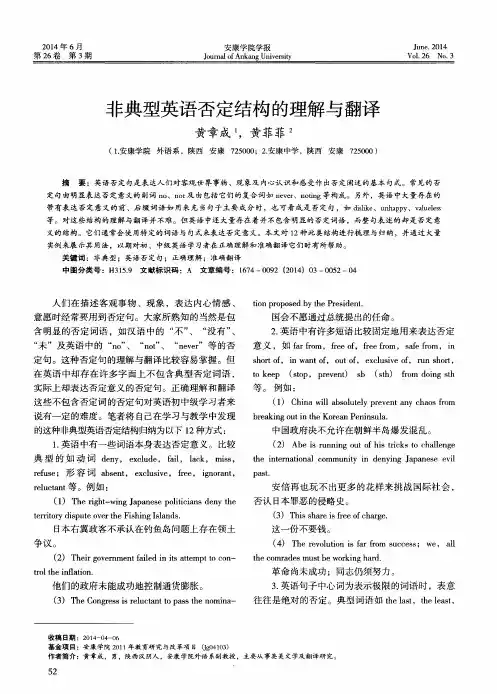

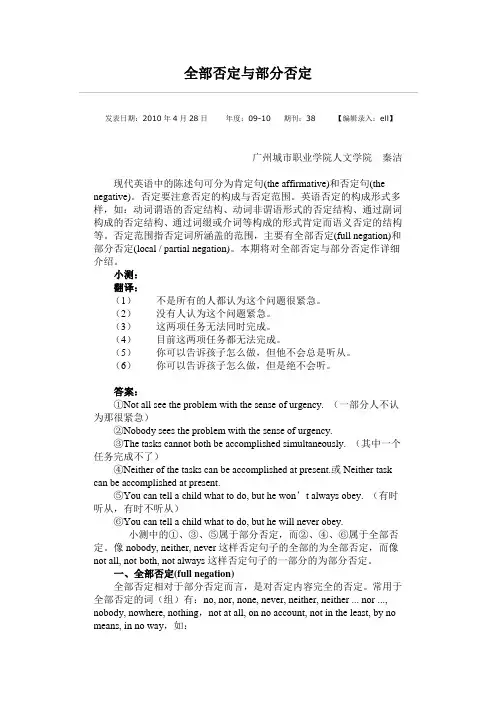
全部否定与部分否定发表日期:2010年4月28日年度:09-10 期刊:38 【编辑录入:ell】广州城市职业学院人文学院秦洁现代英语中的陈述句可分为肯定句(the affirmative)和否定句(the negative)。
否定要注意否定的构成与否定范围。
英语否定的构成形式多样,如:动词谓语的否定结构、动词非谓语形式的否定结构、通过副词构成的否定结构、通过词缀或介词等构成的形式肯定而语义否定的结构等。
否定范围指否定词所涵盖的范围,主要有全部否定(full negation)和部分否定(local / partial negation)。
本期将对全部否定与部分否定作详细介绍。
小测:翻译:(1)不是所有的人都认为这个问题很紧急。
(2)没有人认为这个问题紧急。
(3)这两项任务无法同时完成。
(4)目前这两项任务都无法完成。
(5)你可以告诉孩子怎么做,但他不会总是听从。
(6)你可以告诉孩子怎么做,但是绝不会听。
答案:①Not all see the problem with the sense of urgency. (一部分人不认为那很紧急)②Nobody sees the problem with the sense of urgency.③The tasks cannot both be accomplished simultaneously. (其中一个任务完成不了)④Neither of the tasks can be accomplished at present.或Neither task can be accomplished at present.⑤You can tell a child what to do, but he won’t always obey. (有时听从,有时不听从)⑥You can tell a child what to do, but he will never obey.小测中的①、③、⑤属于部分否定,而②、④、⑥属于全部否定。

英语难句句型(一)双重否定结构[1] There is no rule that has no exception. [译文]任何规则都有例外。
[2] There is not any advantage without disadvantage. [译文]有利必有弊。
[3] I’m not reluctant to accept your proposal. [译文]你的建议我愿意接受。
[4] It is impossible but that a man will make some mistakes. [译文]人不会不犯错误。
[5]Its significance and importance can never be overemphasized.[译文]它的意义和重要性,不管怎样强调,也不算过分。
[6]Hardly a month goes by without word of another survey revealing new depths of scientific illiteracy among U.S. citizens.[译文]美国公民科学知识匮乏的现象日益严重,这种调查报告几乎月月都有。
(二)间接的肯定结构[1] He didn’t half like the girl. [译文]他非常喜欢那姑娘。
[2] I couldn’t feel better. [译文]我觉得好极了![3] I couldn’t agree with you more. [译文]我太赞成你的看法了。
[4] If that isn’t what I want! [译文]我所要的就是这个呀![5] He can’t see you quick enough. [译文]他很想尽快和你见面。
(三)否定的陷阱1.not…because 不是因为……而……[1]The engine didn’t stop because the fuel was finished.[译文]引擎并不是因为燃料耗尽而停止运转。
英译汉中如何翻译否定结构近年来,英译汉的试题难度在加大,主要体现在比较复杂的文章和句子结构比重加大。
五个划线句子中,一般会有1—2个简单句,3—4个复合句;其中复合句存在多个从句嵌套的现象,对考生造成一定理解和表达难度,简单句也因修饰成分繁多、含有抽象意义的词,存在省略和指代等而加大难度。
因此,这五个句子要么语法结构复杂,要么逻辑关系繁复,并且这一现象历年来有增无减,今年也不会例外。
所以建议2021的考生在备考的时候应该把更多的精力真正的放在扎扎实实提高自身英语语言能力、提高对于文章长难句和段落逻辑结构的把握上。
在打下坚实的语言能力基础上,再加上一定的应试技巧和策略,才能真正在考研英语中取得好成绩。
否定结构是英汉两种语言都具有的一种语法现象,但两者在表达否定意义的方式和手段上有很大的差异。
英语中的否定形式很多,常见的有:1全部否定;2部分否定;3双重否定;4形式上肯定,实际上否定;5形式上否定,实际上肯定;6否定转移;7排除否定;8固定句型结构等。
在进行英译汉时对于英语中的否定结构,要从否定词本身的意义、否定词的否定范围、具体的语境等方面予以综合考虑,否则可能造成误解和和重大语义错误。
此外,对于某些否定结构,还可以使用正义反译或反义正译的方法予以处理。
下面就为同学们详细的介绍一下:一、全部否定例如:Nor, as things are, could the actual study of science easily beseparated from technology, on which it has come to depend rather intimately formaterials and apparatus. 本句是全部否定。
Nor, neither, never等词由于句首要倒装,且表示对全句的全部否定,翻译时将否定移回原位。
本句中主句是被动语态,译成主动语态;定语从句很长,而且与原句具有某种因果关系,所以单独翻译;depend on的on被提前。
英语否定结构的译法
英语否定结构是英语中的一种非常重要的句式,也是语言学习者
需要重点掌握的内容之一。
在英语中,通常只要在单词或句子前面加上“not”即可将句子变
成否定句或否定结构,这也是英语最基本的否定结构表达方式,如:
He isn't a student. 他不是学生。
除了使用“not”外,还可以使用其他形式来表达英语否定结构,
如never、no、nothing、nobody等。
这样就可以在句子中表达英语否
定结构,如:He never tells a lie. 他从不撒谎。
此外,英语中还另外有例外否定句这种说法,这种否定句以反意
状语开头,如hardly、rarely、seldom等,如:She hardly ever comes late. 她几乎从不迟到。
在英语中,也有间接否定结构,包括使用“not...either”、“neither...nor”等形式,如:He doesn't like to read, and I don't either. 他不喜欢读书,我也是。
最后,另外还有一种英语否定结构表达形式,即肯定句否定译法,这是一种更为隐晦的译法,在表达上可能更加准确,如:He is not bad. 他不差。
总之,英语否定结构有很多种表达方式,不仅要掌握使用“not”
的基本知识,还需要了解其他形式的表达,如never、no、nothing、nobody等,以及间接否定句和肯定句否定译法等,这样才能正确有效
地表达英语否定结构。
英语否定句用法一、部分否定和全部否定英语中否定句的结构和中文有很多不同的地方,学习者不能用中文的思维方式来逐字翻译成英语的否定句。
例如:All the idioms are not (或:Not all the idioms are)illustrated.初学英语者往往容易按中文的思维习惯,把这句话译成“所有的习语都没有例证。
”这是不对的。
这句话是部分否定,即“不都是”,含义是部分是,部分不是。
翻译成中文是“不是每一个习语都有例证。
”如果说所有的习语都没有例证,英语应该是:None of the idioms is illustrated.这样的例子有很多,请比较下列几组句子:Not both of them can speak English.并不是两人都会说英语。
(部分否定)比较:Neither of them can speak English.两人都不会说英语。
(全部否定)Everyone cannot do it. 并非每个人都能做此事。
(部分否定)比较:No one can do it. 没人能做此事。
(全否)All of us have not been to America. 我们并没都去过美国。
(部分否定)比较:All of us have never been to America. 我们都没去过美国。
(全否)All of us have not done anything wrong. 并不是所有的人都做错了。
(部否)比较All of us have done nothing wrong. 我们都没有做错任何事。
(全否)None of us have done anything wrong. 我们都没有做错任何事。
(全否)All my childre n don’t have any of these bad habits. 并不是我所有的孩子都有这些坏习惯。
(部分否定)比较:All my children have none of these bad habits. 我所有的孩子都没有这些坏习惯。
否定结构翻译一、部分否定(一)英语中的所谓部分否定,是指代词或者副词如all,both,every,everybody,everyday,everyone,many,everything,entirely,altogether,absolutely,wholly,completely,everywhere,always,等与否定词not搭配使用。
部分否定的翻译比较简单,常常翻译为“并非所有,并不是都。
如:all…not(不全是,不都是),both…not(并非两个都,不是两者都),every…not(不是每个都),not always(不总是,不一定),not often(不经常),not altogether(不全是),not necessarily(未必)等。
All that glitters is not gold。
并非所有发光的都是金子。
Both the windows are not open。
两扇窗户并不都是开着的。
Everybody does not believe the rumor。
并不是每个人都听信这个谣言的。
They are not always in the office on Sundays。
他们不一定每个星期天都在办公室。
The responsibility is not altogether mine.责任并不全在于我身上。
(二)需要注意的是,“all…not”和“every…not”等结构属于传统用法。
现代英语中,也会把否定词放在整个句子的最前面,而采用“Not all…”和“Not every…"这种表达形式.这种用法在语法和逻辑上也能讲得通。
Not all metals are good conductors.并非所有的金属都是良导体。
Not everyone accepts his proposal。
并不是所有的人都接受他的建议.二、全部否定在英语中,构成全部否定的单词和词组主要有以下这些:never(决不,从来不),no(没有,不),not(不,不是),none(没人,谁都不,没有任何东西),nobody(没人),nothing (什么也没有,没有任何事情),nowhere(没有什么地方),neither(两者都不),nor (也没有,也不),not at all (一点也不)。
否定结构的翻译否定结构是英语中使用广泛而又较为灵活的一种语言现象。
英汉两种语言在表达否定概念时,运用词汇、语法甚至语言逻辑方面都存在很大差异。
对于同一概念,在英语里通过否定某一成分来表达,而汉语里则通过否定另一成分进行表达。
英语中使用的否定词汇繁多,有很多词汇在形式上不像否定词,但是却表达否定的意义;而汉语里则没有这种现象,使用的否定词只有“不、非、无、否、没有、未、别、莫、勿”等一些简单的词汇。
英语里的否定形式多种多样,其中最常用而且不太好处理的形式大致可以分为五类:全部否定、部分否定、双重否定、形式肯定但意义否定和形式否定但意义肯定。
翻译否定结构时,切不可望文生义,而应该细心揣摩,真正透彻理解其意义,然后根据汉语的表达习惯进行翻译。
只有正确地理解英语中的各种否定句型,才能使译文准确、恰当地表达出原文的含义。
一、全部否定英语中的全部否定通常通过以下否定词来表示: no(没有,不),not(不,不是),none(没人,谁都不,没有任何东西),never(决不,从来不),nobody(没人),nothing(什么也没有,没有任何事情),nowhere(没有什么地方),neither(两者都不),nor(也没有,也不),not at all (一点也不)。
在这些表示完全否定的词语中,no和not的语气最强烈。
no的使用有两个重要特点:第一,no的语气强硬,有“完全不”、“决不”之意,翻译时必须掌握这个分寸;第二,no在英语里总是放在名词前作定语,其否定对象是名词,但在翻译成汉语时,要否定谓语成分。
一定要进行这种转换,否则译文不通,例如:I have no radio.不能直译成“我有无收音机”,而应译成:“我没有收音机”。
这里的“没”字就是对谓语动词“有”的否定。
not也可构成全部否定,但语气不及no强烈,not在英语里用作状语否定动词、形容或其他副词,译成汉语时仍然如此。
否定的词类或成分无需转换,这两点和no的用法有着显著差别,翻译时切忌混淆。
例如:No defects did we find in these circuits.在这些电路中没有发现任何缺陷。
Nowadays it is not difficult to assemble a TV set.现在装一台电视机并不难。
No one has ever found a way to create energy out of nothing.谁也没有找到一种能凭空产生能量的方法。
二、部分否定英语中的部分否定是由代词或者副词,如all, both, every, everybody, everyday, everyone, many, everything, entirely, altogether, absolutely, wholly, completely, everywhere, always, often等,与否定词not结合而成。
not可在上述词语之前,也可在谓语中。
不论not在什么地方,通常都译成“不全是”、“不都是”、“不总是”、“未必都”、“并非”、“不多”、“不常”等。
例如:Not much of the waste oil is utilized.废油被利用的不多。
All mineral don’t come from mines.并非所有矿物都来自矿山。
Both his brothers are not in Wuhan.他的两个兄弟并不都在武汉。
三、双重否定英语句子中,两个表示否定意义的词语连用,就变成了“否定之否定”。
这种否定句叫作双重否定句,但实际上双重否定形式表示强烈的肯定语气,有时也表示委婉的肯定。
翻译时或保持双重否定的形式,或译成肯定的形式,具体可以视汉语的习惯而定。
常见的双重否定形式主要有:no…not (没有……不),without…not(没有……就不),never(no)…without(每逢……总是,没有……不),never (no)…but(没有……不),no (none)…the less(并不……就不),not (never)…unless (不少于,不亚于,和……一样),not…any the less(没有……而少做)。
例如:It is no use learning theory without practice.学习理论而不联系实际是没有用的。
(双重否定译法)或:学习理论一定要联系实际。
(肯定译法)No one had known about the good properties of the substance until that experiment was made.不做完那项实验,没有人知道该物质的良好性能。
(双重否定译法)或:直到做完那项实验以后,才有人知道该物质的良好性能。
(肯定译法)There is no grammatical rule that has no exceptions.没有一条语法规则是没有例外的。
四、形式肯定但意义否定英语里有些词或词组,形式上不像否定词,但意义上却含有否定概念。
这类词或词组,在否定结构中使用广泛,翻译时要多加注意,在汉语中需要将否定意义表现出来。
具体分类说明如下:1)动词及其词组:fail (不;没有),lack(不够),want(缺乏),neglect(不管),miss(没,不),stop(停止;不……),save (keep, pre vent, protect) … from(使不,防止,阻止)。
例如:I failed to adjust well this TV set.我未能调试好这台电视机。
This is a new VTR, but it still wants something of perfection.这是一台新的磁带录相机,但仍有些美中不足。
Neglecting the possible,the test must be continued to the end.不管结果如何,试验必须进行到底。
2)名词及其词组:lack (没有),failure(不能),departure(不成为),spread(不一致),absence(无),freedom from(不受)。
例如:Failure to operate normally made it necessary to give a service.系统不能正常工作,有必要进行维修。
The absence of warm-up time is an advantage of transistors.无预热时间是晶体管的一大优点。
3)形容词及其词组:free of(无),free from(不受),far from(很不),short of(未达到),otherwise(不然),unlikely(未必)。
例如:The measured performances were short of the programmed goal.测得的特性没有达到原定目标。
The rocket traveling in space is free from the earth’s gravity.在太空飞行的火箭不受地球引力的控制。
Some of the machine parts were home-made, some were otherwise.有些机器零件是国产的,有些则不然。
4)副词及其词组:too… to(太……以致不),vainly(不能,徒然),less(不多),easily(不难),apart from(不同于)。
例如:He was too careful an engineer to express his opinion.他是一位非常慎重的工程师,并不随便发表意见。
Before they fled the country, the enemy vainly attempted to destroy all the factories.敌人在逃往国外前, 妄图把所有工厂都毁掉。
5)介词及其词组:without(无,不),beyond(不包括,不在……之内),wanting(如果没有),against(不),out of(不同于),instead of(而不是)。
例如:The parameters of these transistors are beyond specifications.这些晶体管的参数不符合技术规范。
Wanting the successful development of laser, the fibred-optic communication was impossible.如果没有激光器的研制成功,光纤通信就不可能。
6)连词及其词组:rather than(而不是),other than(不是,不同),unless(如果不),but(绝不是),but that(要不是),anything but (决不是)。
例如:Climbing Mt. Everest is anything but a pleasure trip.登珠穆朗玛峰绝不是一次轻松的旅途。
Rather than risk breaking up his marriage he told his wife everything.他惟恐婚姻破裂, 把一切都告诉了妻子。
五、形式否定但意义肯定英语里有些句子形式上是否定的,但是内容含义上却是肯定的。
翻译的时候要根据其隐含的肯定意义译成汉语中的肯定句。
常见的形式上否定但隐含肯定意义的单词和词组主要有:can’t wait to do(急于做),can’t/couldn't+too(越……越……,非常,无论……也不过分),not…until/till(直到……才),never (not)…but (that) (每当……,总是……,没有哪次不是……),nothing /none but (仅仅,只,只有……才),not long before(不久……就……),no / none other than(仅仅,完全),too+形容词/副词+not +不定式(非常……必定能,太……不会不),more often than not(常常,往往),否定词+比较级(相当于最高级),not a little(很,很多)等等。
例如:A book may be compared to your neighbor,if it is good,it can’t last too long;if bad,you can’t get rid of it too early.一本书可以比作你的邻居,如果是好书,保持时间越长越好;如果是坏书,越早丢掉它越好。